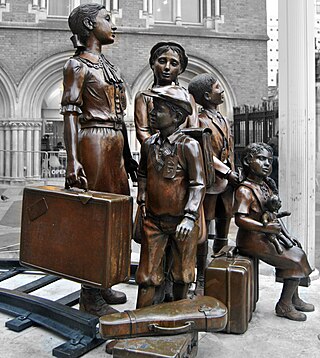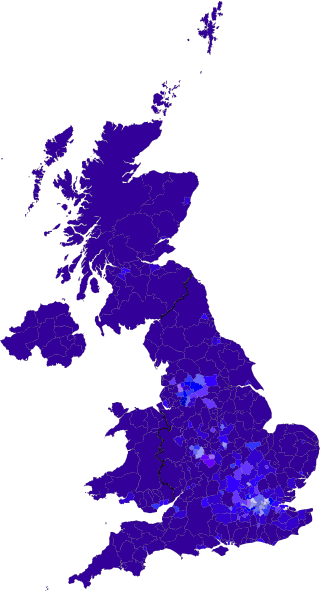
Discrimination is the act of making unfair or prejudicial distinctions between people based on the groups, classes, or other categories to which they belong or are perceived to belong, such as race, gender, age, religion, or sexual orientation. Discrimination especially occurs when individuals or groups are unfairly treated in a way which is worse than other people are treated, on the basis of their actual or perceived membership in certain groups or social categories. It involves restricting members of one group from opportunities or privileges that are available to members of another group.

A ghetto is a part of a city in which members of a minority group live, especially as a result of political, social, legal, environmental or economic pressure. Ghettos are often known for being more impoverished than other areas of the city. Versions of the ghetto appear across the world, each with their own names, classifications, and groupings of people.
Racial discrimination is any discrimination against any individual on the basis of their skin color, race or ethnic origin. Individuals can discriminate by refusing to do business with, socialize with, or share resources with people of a certain group. Governments can discriminate in a de facto fashion or explicitly in law, for example through policies of racial segregation, disparate enforcement of laws, or disproportionate allocation of resources. Some jurisdictions have anti-discrimination laws which prohibit the government or individuals from discriminating based on race in various circumstances. Some institutions and laws use affirmative action to attempt to overcome or compensate for the effects of racial discrimination. In some cases, this is simply enhanced recruitment of members of underrepresented groups; in other cases, there are firm racial quotas. Opponents of strong remedies like quotas characterize them as reverse discrimination, where members of a dominant or majority group are discriminated against.
The term 'minority group' has different usages, depending on the context. According to its common usage, the term minority group can simply be understood in terms of demographic sizes within a population: i.e. a group in society with the least number of individuals, or less than half, is a 'minority’. Usually a minority group is disempowered relative to the majority, and that characteristic lends itself to different applications of the term minority.
The term model minority refers to a minority demographic, defined by factors such as ethnicity, race, or religion, whose members are perceived to achieve a higher socioeconomic status in comparison to the overall population average. Consequently, these groups are often regarded as a reference group for comparison to external groups (outgroups). This success is typically assessed through metrics including educational attainment, representation within managerial and professional occupations, household income, and various other socioeconomic indicators such as criminal activity and strong family and marital stability. The prominent association of the model minority concept is with Asian Americans within the United States. Additionally, analogous concepts of classism have been observed in numerous European countries, leading to the stereotyping of specific ethnic groups.
The United Kingdom is an ethnically diverse society. The largest ethnic group in the United Kingdom is White British, followed by Asian British. Ethnicity in the United Kingdom is formally recorded at the national level through a census. The 2011 United Kingdom census recorded a reduced share of White British people in the United Kingdom from the previous 2001 United Kingdom census. Factors that are contributing to the growth of minority populations are varied in nature, including differing birth rates and Immigration.
Employment discrimination is a form of illegal discrimination in the workplace based on legally protected characteristics. In the U.S., federal anti-discrimination law prohibits discrimination by employers against employees based on age, race, gender, sex, religion, national origin, and physical or mental disability. State and local laws often protect additional characteristics such as marital status, veteran status and caregiver/familial status. Earnings differentials or occupational differentiation—where differences in pay come from differences in qualifications or responsibilities—should not be confused with employment discrimination. Discrimination can be intended and involve disparate treatment of a group or be unintended, yet create disparate impact for a group.
Dropping out refers to leaving high school, college, university or another group for practical reasons, necessities, inability, apathy, or disillusionment with the system from which the individual in question leaves.

The demography of London is analysed by the Office for National Statistics and data is produced for each of the Greater London wards, the City of London and the 32 London boroughs, the Inner London and Outer London statistical sub-regions, each of the Parliamentary constituencies in London, and for all of Greater London as a whole. Additionally, data is produced for the Greater London Urban Area. Statistical information is produced about the size and geographical breakdown of the population, the number of people entering and leaving country and the number of people in each demographic subgroup. The total population of London as of 2021 is 8,799,800.

The sociology of education is the study of how public institutions and individual experiences affect education and its outcomes. It is mostly concerned with the public schooling systems of modern industrial societies, including the expansion of higher, further, adult, and continuing education.<re it means to provide help

The sociology of immigration involves the sociological analysis of immigration, particularly with respect to race and ethnicity, social structure, and political policy. Important concepts include assimilation, enculturation, marginalization, multiculturalism, postcolonialism, transnationalism and social cohesion.
Active labour market policies (ALMPs) are government programmes that intervene in the labour market to help the unemployed find work, but also for the underemployed and employees looking for better jobs. In contrast, passive labour market policies involve expenditures on unemployment benefits and early retirement. Historically, labour market policies have developed in response to both market failures and socially/politically unacceptable outcomes within the labor market. Labour market issues include, for instance, the imbalance between labour supply and demand, inadequate income support, shortages of skilled workers, or discrimination against disadvantaged workers.
A number of different systems of classification of ethnicity in the United Kingdom exist. These schemata have been the subject of debate, including about the nature of ethnicity, how or whether it can be categorised, and the relationship between ethnicity, race, and nationality.

İbrahim Sirkeci is a British Turkish social scientist, currently Head of Enterprise Subject Group at Salford Business School, University of Salford, Manchester, UK. He served as a Professor at various British universities including his 16 years long service at the European Business School London, Regent's University London, and was the Director of Regent's Centre for Transnational Studies.
Occupational segregation is the distribution of workers across and within occupations, based upon demographic characteristics, most often gender. Other types of occupational segregation include racial and ethnicity segregation, and sexual orientation segregation. These demographic characteristics often intersect. While a job refers to an actual position in a firm or industry, an occupation represents a group of similar jobs that require similar skill requirements and duties. Many occupations are segregated within themselves because of the differing jobs, but this is difficult to detect in terms of occupational data. Occupational segregation compares different groups and their occupations within the context of the entire labor force. The value or prestige of the jobs are typically not factored into the measurements.

Youth exclusion is a form of social exclusion in which youth are at a social disadvantage in joining institutions and organizations in their societies. Troubled economies, lack of governmental programs, and barriers to education are examples of dysfunctions within social institutions that contribute to youth exclusion by making it more difficult for youth to transition into adulthood. European governments have recently recognized these shortcomings in societies organizational structures and have begun to re-examine policies regarding social exclusion. Many policies dealing with social exclusion are targeted at youth since this demographic of people face a transition into adulthood; defining career and lifestyle choices that will affect the future culture and structure of a society.
Multiculturalism in the Netherlands began with major increases in immigration during the 1950s and 1960s. As a consequence, an official national policy of multiculturalism was adopted in the early 1980s. This policy subsequently gave way to more assimilationist policies in the 1990s and post-electoral surveys uniformly showed from 1994 onwards that a majority preferred that immigrants assimilated rather than retained the culture of their country of origin. Even though the general acceptance of immigrants increased, opinion polls from the early 1980s and after showed that many were critical of immigration. Following the murders of Pim Fortuyn and Theo van Gogh the political debate on the role of multiculturalism in the Netherlands reached new heights.
In the United States, despite the efforts of equality proponents, income inequality persists among races and ethnicities. Asian Americans have the highest median income, followed by White Americans, Hispanic Americans, African Americans, and Native Americans. A variety of explanations for these differences have been proposed—such as differing access to education, two parent home family structure, high school dropout rates and experience of discrimination and deep-seated and systemic anti-Black racism—and the topic is highly controversial.
Anthony Francis Heath, CBE, FBA is a British sociologist who is a professor of sociology at Oxford University and a professorial fellow of Nuffield College, Oxford.

White people in the United Kingdom are a multi-ethnic group of UK residents who identify as and are perceived to be 'white people'. White people constitute the historical and current majority of the people living in the United Kingdom, with 87.2% of the population identifying as white in the 2011 United Kingdom census.








